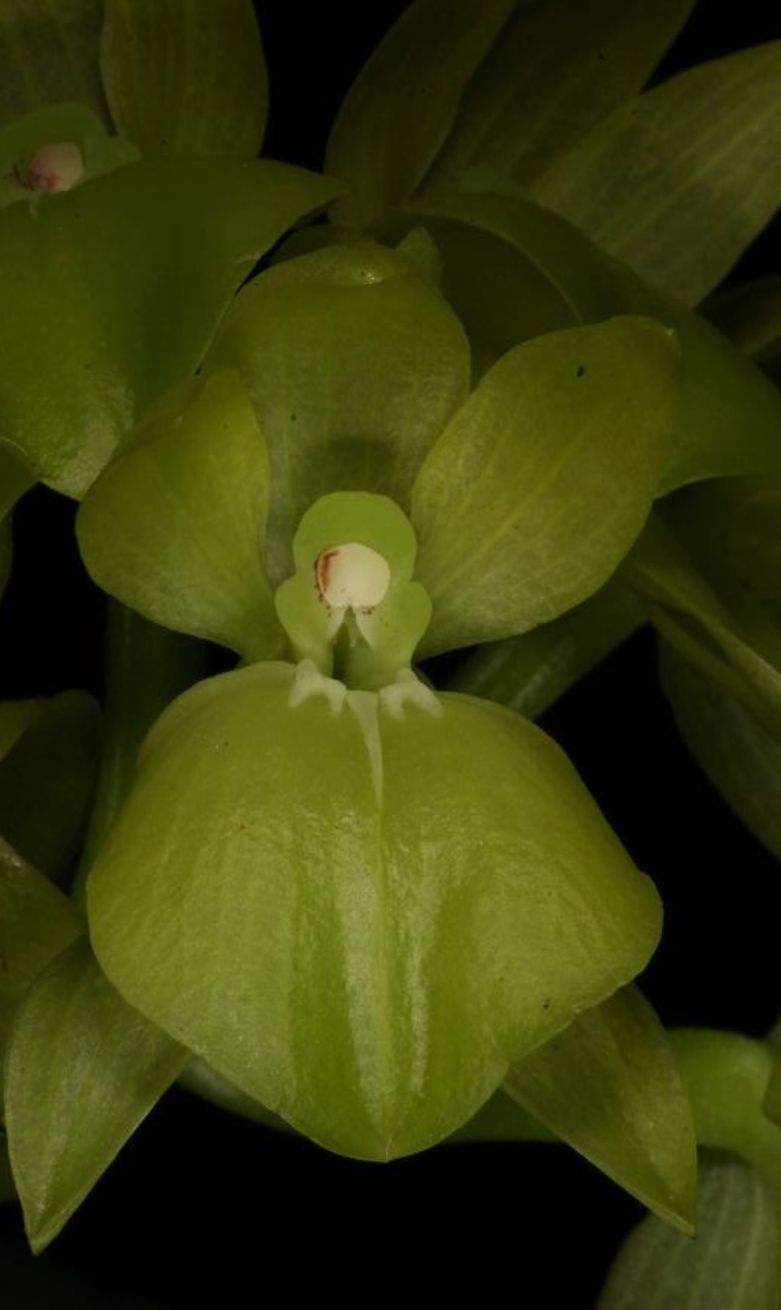

Epidendrum scutella Lindl. 1844 GROUP Megalospathum
Photos by © Rebecca Repasky and The Atrium Website
TYPE Drawing by © Jimenez, Hágsater & E.Santiago and The AMO Herbario Website
Original Drawing by © Padre Pedro Ortiz Conserved at the Herbario de la Universidad Javeriana, Bogota Colombia




Common Name The Small Cupped Epidendrum [refers to the base of the lip]
Flower Size 1.2" [3 cm]
Found in Venezuela, Colombia, Ecuador and Peru in rather scrubby cloud forests at elevations around 3000 to 3100 meters as a medium sized, cold growing epiphyte with simple, cane-like, terete, base covered by 1 or 2, tubular, non-foliar, scarious sheaths, pendant, branched stems enveloped completely by imbricating leafless and leaf bearing sheaths and carrying 6 to 10, apical, alternate, articulate, unequal in size (the basal one smaller), softly coriaceous, sharp-edged, ovate-lanceolate, acute, margin entire leaves that blooms in the fall on a subsessile, arising through a conduplicate, obliquely ovate, apex rounded, margin entire spathaceous bract, on a recently matured stem, peduncle .2" [5 mm] long, thick, laterally compressed, erect, straight; rachis .282 [7 mm] long, laterally compressed, both generally totally hidden within the spathaceous bract, subumbellate to 2.8 to 3.2" [7 to 8 cm] long, simultaneously 5 flowered inflorescence and has small infundibuliform floral bracts and carrying resupinate, lime-green or yellowish green flowers with the calli and the mid-rib white and a fragrance in the afternoon and especially after sundown, of citrus.
" Epidendrum scutella belongs to GROUP Megalospathum characterized by the caespitose but branching habit, many leaved stem, fleshy, oblique leaves, a short, few flowered raceme subtended by large semi-ovate spathaceous bracts, resupinate flowers, and the column more or less united to the lip. The species is recognized by the robust, compact stems, leaves ovate-lanceolate 1.88 to 4.8" [4.7 to 12 cm] long, with an acute apex, the inflorescence is generally 5-flowered, the flowers lime-green or yellowish green, the lip orbicular to elliptic-orbicular, the base cordate, apex sub-obtuse, and calli small, each prolonged by 2 to 3 short ribs, with an additional mid-rib, narrow, low, acuminate, reaching the middle of the blade. Epidendrum rhomboscutellum Hágsater & E. Santiago has thin stems, narrowly lanceolate leaves .8 to 2.4" [2 to 6 cm] long, the apex acuminate, the inflorescence is 2 flowered, the flowers greenish yellow with the apex of the petals reddish brown, the lip is obovate-rhombic with the base cuneate, and the apex acute, the disc with a pair of globose calli. Epidendrum rhodochilum (Schltr.) Hágsater & Dodson has pendent plants, green flowers with a red lip, the flowers are smaller, the sepals .68" [17 mm] long, lip is obovate, obtuse, with the margin denticulate and the lip is free from the column. Epidendrum megalospathum Rchb.f. has an oblong-ovate lip with the apical margin denticulate, the elongate rachis has 6 to 7, laxly distributed flowers, and the lip is partly free from the column. Epidendrum lagotis Rchb.f. has narrowly ovate-elliptic leaves .8 to 2.4" x .4 to .92" [2 to 6 x 1.0 to 2.3 cm], a 2-flowered inflorescence, orbicular lip, nearly as wide as it is long, and the petals are spatulate, with the apex somewhat rounded. Epidendrum miradoranum Dodson & Bennett also has ovate-lanceolate leaves, but these are shorter .4 to 1! [1 to 2.5 cm] long, the apex acuminate, the inflorescence has up to 4, pale green flowers with discontinuous, pale purple lines, the lip is widely cordiform, bicallose and without keels." Hagsater etal 2015
Some authors cite E platyoon as a synonym of this species but E platyoon most likely has a single flowered inflorescence with a pair of small calli that do not terminate in 3 keels instead of a 4 to 7 flowered inflorescence with calli that terminate in 3 keels.
Synonyms
References W3 Tropicos, Kew Monocot list , IPNI ; Bonplandia Rchb.f 1854; Repert. Spec. Nov. Regni Veg. Beih. 6: 72 Schlechter 1919; Repert. Spec. Nov. Regni Veg. Beih. 7: 251 Schlechter 1920; Die Orchideen der Sudamerikanischen Kordillerenstaaten IV Peru Schlechter 1921 as E platyoon; Repert. Sp. Nov. Regni. Veg. Beih. 27: 74 Colombia Schlechter 1924 ; Orchids of Peru Vol 2 Schweinfurth 1959; Venezuelan Orchids Illustrated Vol 3 Dunsterville & Garay 1965 drawing fide; Flora de Venezuela Volumen 15 Parte 3 Foldats 1970 drawing good; Orchids of Venezuela, An Illustrated Field Guide Vol 1 Dunsterville & Garay 1979 drawing fide; Venezuela, Paraiso de Orquideas Romero 1997 photo fide; Orchids of Venezuela [An illustrated field guide] Vol. 1 Ramiro and Carnevali 2000 drawing fide; Icones Orchidacearum Peruviarum Plate 654 Bennett & Christenson 2001 drawing ok; Orquideas Nativas del Tachira Cesar Fernandez 2003 photo fide; Machu Picchu Orchids Christenson 2003 photo good; Icones Orchidacearum 14 Plate 1481 Hagsater & Sanchez 2013 see recognition section; Icones Orchidacearum 15 [1] Plate 1532 Hagsater & Sanchez 2015 see recognition section; Icones Orchidacearum 15 [1] Plate 1559 Hagsater & Sanchez 2015 drawing/photo fide; Orquideas, Tesoro de Colombia Vol 2 Ortiz & Uribe 2017 drawing/photo fide;
--------------------------------------------------------------------------------------------------------------------------
-------------------------------------------------------------------------------------------------------------------------